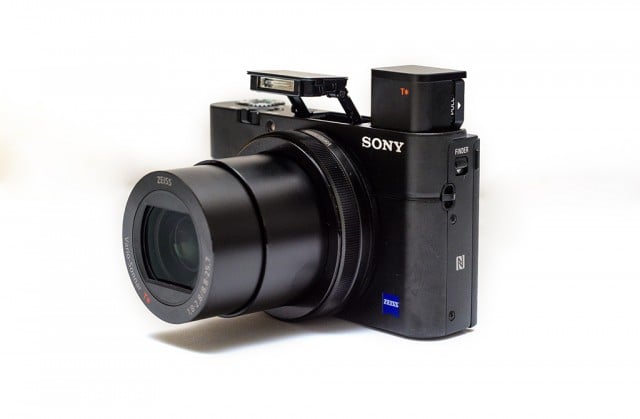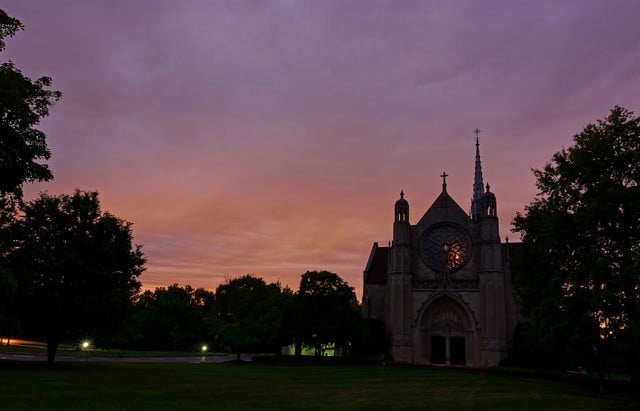Sony RX100 III Review
The Sony RX100 M3 is the newest advanced-level point and shoot camera, and further improves on Sony’s RX100 line to maintain its place as the best point & shoot camera currently on the market. I’ll make that much clear from the outset: the Sony RX100 III is without a doubt superior to every other pocket point and shoot camera, and for many people it will rival a mirrorless or DSLR system. This camera is that good. It is loaded with features and so much excellence is crammed into this little camera that it really is a feat of engineering.
This should really come as no surprise to photography enthusiasts. For each of the past three years, Sony has released a new camera in the RX100 line, each of which has taken the crown as ‘best point and shoot’ with its release. I won’t bother going into the line’s history or explain why it’s so technically impressive–if you’re interested in that, check out my original Sony RX100 Review. In terms of image quality, everything that I wrote of the original Sony RX100 is true of the new RX100 III, except perhaps to a greater degree. The new Sony Rx100 camera always has new bells and whistles…and has a higher price tag. In this Sony RX100 III review, we will take a look at the newest Sony RX100, and judge whether it’s worth the added cost over previous models in light of the new features it brings to the table.
For this version of the Sony RX100, a lot has changed. Much more than changed with the Sony RX100 II, which was an improvement, but the model many photographers skipped. The Sony RX100 III is a very worthy upgrade that brings a lot more to the table, but it also brings a considerably higher price, too. This is what has me torn on the camera: on the one hand it does take the ‘enthusiast point and shoot’ camera concept to the next level with upgrades in both features and image quality, but on the other hand, might the money be better spent elsewhere?
One of the biggest new features of the Sony RX100 III is the 24-70mm f/1.8 – f/2.8 zoom lens. While the lens on the previous iteration was 28-100mm, so it technically offered more range, those 4mm extra on the wide end, I think, make the range a wash even considering the 30mm lost on the telephoto end. On the wide end, 4mm make a huge difference in terms of field of view. More importantly, the lens now maxes out at f/2.8 on the telephoto end, whereas the previous versions maxed out at f/4.9 on the the telephoto end. I wish the lens had a bit more reach, but if this was the compromise that had to be made for it to be wider and faster, I’ll take it.
This is a significant difference in aperture, and means that the low light performance of the Sony RX100 III is improved, even if there were otherwise no sensor improvements. Same goes for shallow depth of field shots, and the Sony RX100 is now more capable of shallow depth of field photos without the subject being super-close to the lens. It still isn’t capable of what a DSLR and prime lens can do in terms of depth of field, but it’s pretty astonishing for a point and shoot.
The Sony RX100 III has a new, Bionz X image processor that really helps with speed (especially shooting raw) more than anything else. In theory, it could also help improve image quality, dynamic range, and high ISO performance, but image quality might also be affected by the new, nicer lens. While I notice some improvements in all three regards over the original RX100, they are not what I would consider substantial. There does seem to be a bit more fine detail in photos and more dynamic range in raw files, but not a ton. High ISO performance has improved on paper, but for practical purposes, I still wouldn’t want to go above ISO 1600 or maybe ISO 3200. Maybe someone better equipped to pixel peep would know better than I, but I can’t spot any substantial differences in terms of image quality.
In terms of ancillary features, a big one is the electronic viewfinder. This viewfinder pops up, seemingly out of nowhere like a ninja poised for battle. How Sony managed to fit this, the lens, the pop-up flash, and the guts necessary for such a camera is nothing short of magical. The EVF functions exactly as it should, and while small, it gets the job done. I found myself reluctant to use the EVF in most situations because of its drain on the battery, and because the camera oddly powers down when the EVF is retracted. Most of the time, when I was done using the EVF, I was done using it, not the camera. Hopefully Sony offers a firmware fix for this.
Beyond this, there are several new bells and whistles. The built in 3-stop neutral density filter is nice, and while it primarily helps with video and daytime shooting at f/1.8, I think it could come in handy for fireworks. The articulating LCD screen is another feature for which I have a lot of use, as it helps with shooting at difficult angles. Built in WiFi is another nice feature. As with many point and shoot cameras, it also has a ton of automatic modes and other approachable features. I tested out the built-in HDR, which is quite adept. The photo below is a 5EV dusk shot of a church near my home using the HDR feature. Not technically perfect, but pretty good.
Another area of significant import is the improvements made to the Sony RX100 III’s video. A new video codec, XAVC S, offers pro-level 50 Mbps for video shooting. I suppose this is a big deal for those shooting video heavily. Unfortunately, I don’t use video much, so I can’t really judge this one.
This camera is also slightly larger and heavier, but neither of these things will be significant issues. It’s still pocket size and pocket weight, it’s now just a bigger bulge in your pocket. Anyone over the age of 3 years old will have no problem holding it.
My main issue with the Sony RX100 III on a personal level, as someone who already owned the RX100, is the relative lack of gains in image quality. To be sure, the new lens is great, the extra bells and whistles are really nice, and Sony has crammed a lot into this camera, but I have to ask myself whether they are things I really need. Of everything, only the new lens stands out as something really “important,” and I don’t think I can justify the extra cost for that new lens alone without much in the way of actual image quality improvements. The Sony RX100 III is far from a slouch in terms of image quality, but if I’m concerned about the results produced by a f/1.8 or f/2.8 lens, chances are I’m more concerned about image quality and going to want to use one of my DSLRs for heavy lifting.
This leads to my big issue with this camera in general, and that’s where it fits into the market. It is doubtlessly an absolutely incredible camera. What it can accomplish is unheard of for a point and shoot camera, and its performance is second to none in terms of pocket-sized point and shoot cameras. However (you had to know one of those was coming), it represents less of a leap over the competition (namely, its predecessors in the RX100 line) than the original RX100 did when it was released, and the $800 price tag should give a lot of potential customers pause.
This is especially true when the original Sony RX100 can now be picked up for around $500 new or $425 refurbished. That makes the RX100 III nearly double the cost of the first generation, and most RX100 users will not get twice as much out of the RX100 III. Now, it’s true that there is a law of diminishing returns when it comes to photography equipment. A $1,500 pro-grade lens isn’t going to be three times as nice as a $500 third party lens that does the same thing. However, that is in terms of professional equipment, and most professionals are comfortable paying a lot more for incremental improvements.
This point and shoot is an enthusiast product, something that will either be used by serious hobbyists as a pocket-sized camera to keep with them at all times instead of their main and/or secondary DSLR, or something that will be purchased by amateurs/enthusiasts as opposed to a DSLR because being able to put the camera in their pocket is really important to them–but so is quality and performance.
With that in mind, if money is absolutely no concern, both groups should purchase the Sony RX100 III rather than earlier incarnations of the RX100. The upgrades are significant-enough such that you’re not just throwing away that extra money on the RX100 III, even if you do have it to burn.
However, if money is a concern, it becomes a much closer question. For the serious photographer who wants a point and shoot as a second or third camera “just in case,” I have a very difficult time justifying ~$300+ extra for this camera. If it’s going to be relegated to “just in case” status and you have another primary system, that $300 or so is probably better spent elsewhere. By contrast, even a budget-conscious consumer may get enough extra mileage out of the RX100 III if it’s going to be their primary camera and they are concerned about quality.
Whether the RX100 M3 is right for you is really a question of how regularly and seriously it will be used, and how much the above features and new lens appeal to you. If you like the new lens and will get a lot out of these features, get the RX100 III. If you intend to casually use a point & shoot and these features and lens don’t matter much, get the original RX100. Of course, all of this assumes you should get the RX100 series over a DSLR in the first place…
Even though the RX100 III is more expensive than a DSLR, a DSLR does best it in terms of image quality. People considering the RX100 series over a DSLR for their primary camera in the first place should be those to whom pocket size is a really, really big deal. The RX100 series has great image quality, but if image quality is of paramount importance, go for an entry level DSLR. It’s really a judgment call, and only you know what matters more to you. The Sony RX100 III is sort of a ‘have your cake and eat it too’ type camera for those who want point and shoot size, yet still having a heavy feature set and near-DSLR image quality…but all of that comes at a steep price.
Overall, this is sort of where I am at with the Sony RX100 III, personally. It is the best point and shoot camera I’ve ever touched, and I would love to keep it because its quality and features are great, but if I’m being honest with myself, I’m not seeing a big enough gain over the original Sony RX100 in terms of image quality to justify its added cost. Many other bells and whistles have been added that are mostly great, but for me personally, this is not enough of an improvement for the added cost. This is especially true since this is a backup camera for me that really only gets a workout when I’m not using my DSLR (and even more true since the Nikon D810 was just announced and I need to put my photography funds towards that). I don’t know what I was expecting out of the Sony RX100 III, but for the price, I guess a little more…so I plan on returning it and going back to the original RX100. If you find yourself agreeing with me, I’d encourage you to hold onto your original Sony RX100, or pick it up for the current bargain price in lieu of the newer version. This is not to say it’s a bad upgrade or purchase for everyone–far from it–but it’s also not a point and shoot that is for everyone. It’s really only for those who want the absolute best quality from their point and shoot camera, and don’t care at what cost that comes. If you want to ‘have your cake and eat it too’ with the Sony RX100 III, you can purchase it here.
If you’re looking for other photography equipment recommendations or photography tips in general check out a few of my top photography blog posts:
Photography Buying Guide: Way More Than You Ever Needed to Know…
Best Books for Improving Your Photography
5 Indispensable Tips for Better Vacation Photos
Neutral Density Filter Buying Guide
Travel Tripod Buying Guide
Your Thoughts…
Do you own any of the Sony RX100 cameras? What do you think of yours? Considering upgrading to the Sony RX100 III? Share your thoughts or questions below in the comments!




Hey Tom. I got this camera during Amazon’s Prime day as a scratch and dent for $511. It was in package and unused, just a busted corner in the charger. The tilt screen and EVF are super-nifty.
I love it. It’s great. I suck.
I am a horrible photographer. Is there a “for dummies” book I should read?
Dan, you should check out Bryan Peterson’s book Understanding Exposure.
Tom also recommends it here: https://www.disneytouristblog.com/photography-camera-reviews-disney/
Thank you Tom,you helped me with your great review from all different ways as I am totally a photograph lover full with amateur feelings. I had 6 years old nikon but for some reason I have never been satisfied with its colors and sharpness especially at dark ambiances. So few of my friends were happy with RX II and while I decided to upgrade and update my camera , I decided to get the latest version even maybe I may not need some of the technical details but you never be sure of it,right?So your review helped me so much and thank you , ı think I will get RXIII. / Sukru – from Turkey
I have the original RX100 and intend to bring it to our first trip to Disney World this fall. I agree with your assessment, I don’t see enough of a change to justify the cost. I would rather put the money into saving up for a D810. Having said that, I was wondering if you have ever looked at the Sony RX-1 and what your thoughts would be about using that on dark rides and as a general walk around Disney Camera. I know this is off topic, but I couldn’t find anywhere more appropriate and I would be really interested in your thoughts.
By the way, I have been a longtime fan of yours. I very much appreciate your artistic style and witty commentary. Not that I don’t enjoy other disney blogs, but I definitely appreciate the writings of a fellow attorney.
I would also like to point out how cheap you can get a copy of the rx100 or rx100 II used at a site like Amazon, B&H photo or KEH.com with a warranty and peace of mind when compared with eBay purchases. Just order like new and you can save hundreds of dollars.
Great point. The RX100/II used or refurbished is a bargain at this point.
Hi, Thank you for your thorough review on the rx100iii What I am wondering and couldn’t glean from your review is if this is the right camera for me.
I own a DSLR but don’t usually use it because of convenience and portability.
I am looking for a small camera which I can carry around with me and that will take DSLR like photos which can capture my kids as they are running around and playing. I am not an enthusiast don’t know much about cameras just a busy mom who wants some good pictures of fast blurry kids often in low light.
So what I want to know is what camera you think would be best for me? Is the mark 3 better for this than the mark 2? Or is there another compact that would be better?
Thanks I really appreciate any info you can give me.
Debbie
I don’t know what you consider “small” – but you obviously want something lighter and more compact than a full-size, heavy DSLR.
I have a Sony NEX-5N and it’s great for action shots of the kids. It’s fairly lightweight, compact, and easy to carry around, especially with the 16mm pancake kit lens. Newer versions of the Sony NEX series are available, obviously, but you can save quite a bit of money on a used/refurbished NEX camera body and allocate the savings towards a fast prime e-mount lens that would be great at capturing your kids’ shenanigans and also work very well in low light. If you’re looking for the newest technology and best performance, check out the Sony a6000.
For travel and vacations, a compact camera is much easier to tote around than a DSLR or mirrorless camera. Any one of the three RX-100 models is *highly* recommended, depending on your budget. (I just bought the RX-100 M3 because of the phenomenal performance and convenient size. Works great for kid pics!)
If you have a little more cash to throw down, Sony just released the a7s – a “compact” DSLR type with the sensor and processor tweaked to perform amazingly well in low light – the ISO can be pushed to 409,200 – and still turn out very usable prints of the kids!
Anyhow – there is no way to make adequate recommendations in this forum – you’ll need to do your own research to determine which camera will serve your needs best. And don’t be afraid to keep your wallet happy by purchasing used / refurbished equipment from reputable camera dealers… Good luck!
I’m not going to lie, I’ve been eyeing up this camera. I don’t for the life of me know why, but I can’t resist it’s allure.
Your review certainly isn’t helping, thanks!
ya the rx100 is a cool camera i really like the color on sony cameras. but the d810 looks like it will be cool i wonder how it will compare to the d800e. dose anyone know if nikon is still using sony sensors in some of there cameras. grate review tom. the post on the site lately hhave been grate!! KEEP EM COMING
The assumption for a long time is that Nikon uses Sony sensors in its high-end DSLRs. That has never officially been confirmed, but everyone pretty much believes it to be true.
Based on the specs, it looks like the Nikon D810 has a Sony sensor, too.
Tom, do you realize that you have a view finder on this one that you didn’t had on the others and that’s where a big part of the difference of price with the previous versions is coming from? $799 is indeed a high price but the image quality of this so small camera is astounding, and the viewfinder is extremely good and sharp. They just need to fix the problem of the camera being shut down when you stop to use the viewfinder and everything will be perfect.
I mention the new EVF extensively in the review, so yes, I’m aware that it has one.
For me–personally–the EVF is not worth the cost difference. YMMV on whether it is for you. Even the new, superior lens plus the EVF isn’t worth it to me.
Nice review. I got many useful information’s after reading this blog. Thanks a lot for sharing.
Thanks for a great review Tom. I purchased the RX100 6 months ago and love it for its compactness. I have contemplated selling it and getting the newer M3 for the tilt screen and EVF but couldn’t justify the expense TBH. I’m off to Florida in 2 weeks with the wife & kids, I contemplated taking the D800 but have decided to travel light and just take the RX100.
You have a great blog and lifestyle 🙂
The $400 you’d be out is a *lot* of money for just the tilt screen and EVF, in my opinion. Now, if that lens really appealed to you and you’d be using the camera a ton, I’d say go for it…
I haven’t owned the other versions of the rx100, but I made the plunge on the M3
and I love it. I actually sold my mirrorless (It was
a Canon EOS M so it really wasn’t that hard of a choice) to get this camera. The built in EVF is amazing and I can’t wait to try it out on some dark rides!
I never really thought about the value of the EVF on dark rides. For Disney purposes, that’s a fairly big deal!